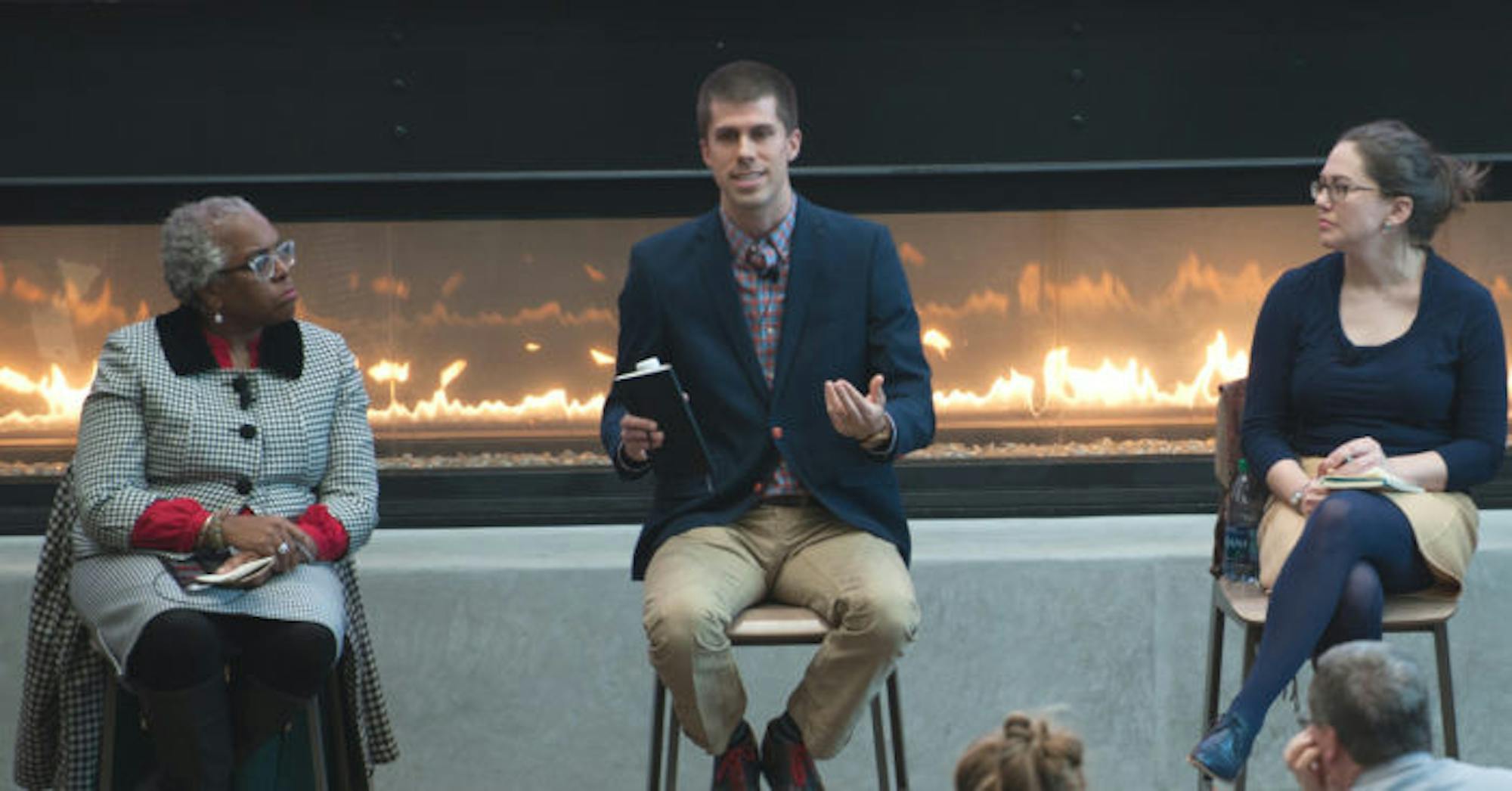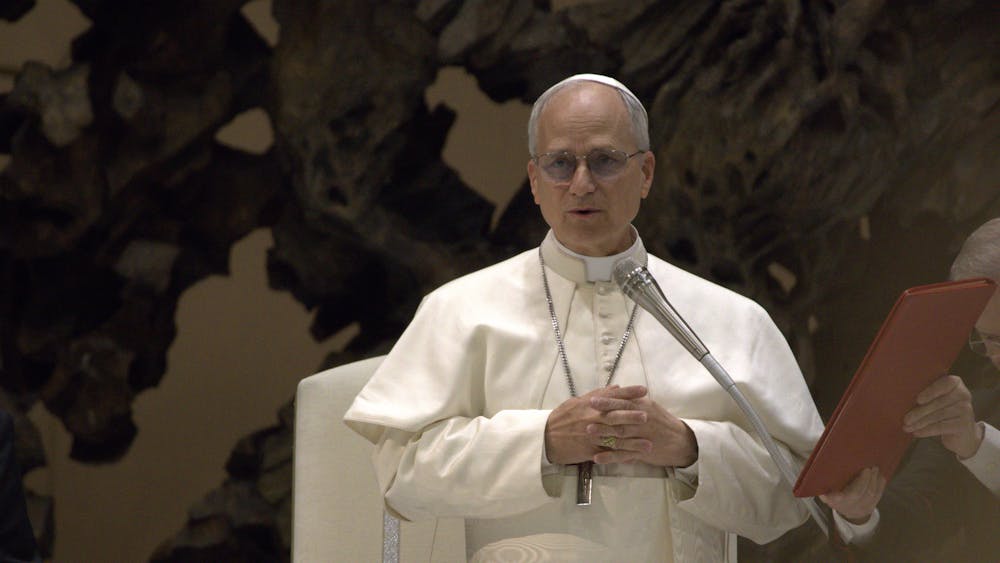As the kick-off event for Black Catholic History month and Notre Dame’s annual Stand Against Hate Week, a public panel reflected on the shared features of two contemporary social justice movements in a panel entitled “Is ‘Black Lives Matter’ a Pro-Life Issue?” The panel was held Monday afternoon in the Duncan Student Center.
The panel was comprised of Jessica Keating, director of the Notre Dame Office of Human Dignity and Life Initiatives, Kyle Lantz, director of social concern seminars at the Center for Social Concerns and Shawnee Daniels-Sykes, a Catholic theological ethicist and associate professor of theology at Mount Mary University. The event was organized by Campus Ministry, the Gender Relations Center, Multicultural Student Programs and Services and Notre Dame Right to Life.
Discussion began with a brief explanation of both movements. Moderator Kayla August, assistant director of evangelization for Campus Ministry, said the Black Lives Matter movement was not limited to black people, just as the pro-life movement was not limited to only opposing abortion.
“The primary mission of Black Lives Matter is to work vigorously for freedom and justice for black people, and by extension, all people, giving the movement a highly intersectional position, extending efforts to all marginalized populations,” she said.
The first topic the panel discussed was the Catholic Church’s definition of human dignity.
“The concept of human dignity is under attack right now in the United States and in Western Europe as well,” Keating said. “This is a real challenge for us in the Church ... to make this argument for human dignity.”
She said people were ordered to help one another, citing the history of Christians caring for society’s most vulnerable and unwanted populations, such as children left to die through exposure to the elements.
“That was the ancient world's way of abortion,” she said.
Daniels-Sykes connected the concept of human dignity to Black Lives Matter by exploring a parallel between the types of vulnerability represented in each movement.
“The Black Lives Matter movement symbolizes a visible vulnerability,” she said. “The pro-life movement symbolizes a non-visible [vulnerability] because the unborn fetus is in the womb.”
She attributed the vulnerability of African Americans to implicit bias, citing the deaths of Tamir Rice and John Crawford III, both young African American men who were fatally shot by police officers.
“Life has been snuffed out for centuries ... this country is based on the [perceived] suspiciousness of people of African descent,” Daniels-Sykes said. “At the heart of [the Black Lives Matter conversation] is a cry that says, ‘I need you to hear that something is wrong. Something is wrong and something needs to be addressed.’”
The panelists also spoke about what they felt were common misperceptions of each movement. Speaking from her personal experience as a former pro-choice believer, Keating said the portrayal of pro-life as a homogenous, conservative movement was not accurate. Daniels-Sykes said Black Lives Matter was often portrayed unfairly by the media in a negative and violent light.
“Social justice and pro-life are just indivisible in our culture right now,” Keating said. “This idea that life from the womb to the end of life, issues of racism, issues of poverty, these all start to interconnect when you dig into one issue ... abortion is related to race, it’s related to domestic violence — it’s a huge predictor.”
Lantz said most of these misperceptions depend on the people an individual chooses to be around. He said it was easy to reject an entire movement because of one’s dislike for a single aspect of that movement and that individuals were more likely to dismiss injustice if it didn't affect them personally.
“If my perceptions are based on those I interact with or what I choose to read, I can easily find something to lift up the worst of the other movement and find an example that shows, ‘I don’t care.’” Lantz said.
When asked how the two movements fit into the modern pursuit of justice, Keating said a vision of justice begins with remembering and taking ownership of history.
“We are a culture that doesn’t remember [our history] anymore,” she said. “Very often, white Americans say, ‘Well I wasn’t a part of racism or slavery,’ distancing ourselves from those effects. But we are Americans, and as Americans, we take on the history of America.”
The panelists also agreed the Catholic Church was not perfect in its handling of Black Lives Matter, saying there was room for improvement.
“The Church in America is still one of the most segregated places in the country,” Lantz said.
Lantz added that church communities tend to address issues most pertinent to themselves and mentioned the difference in interest he witnessed between the attitudes of black churches and white churches when it came to Black Lives Matter.
Keating brought up the problem of service learning, saying that while it was good to bring help to communities and movements that needed it, the temporary nature of that type of aid made it problematic.
Attendees were invited to text questions for the panel at any time using the number listed on the large screen in Midfield Commons. One student asked about how to build common ground between the two movements, saying they felt both movements were polarized on campus.
Keating's advice was to own both movements by talking about them openly, making the point of both movements being about the preservation of life. Lantz suggested taking an inquisitive approach if speaking out felt too difficult, saying questions were a good starting point for effective conversation.
Despite the progress that needs to be made by the Catholic Church in supporting Black Lives Matter, Keating said Catholic teachings were a useful lens to help discern the commonalities between various social justice issues.
“Learning the narrative of the scripture, as Christians, is sort of essential,” she said. “It allows you to move with facility between all of these concrete issues which we tend to separate and keep in their own boxes. Knowing the narrative of scripture, we can understand how these all link together when we think about issues of justice.”
Panel examines intersection of pro-life, Black Lives Matter movement
Emma Farnan | The Observer
Shawnee Daniels-Sykes, left, Kyle Lantz and Jessica Keating discuss the intersection of the pro-life movement and the Black Lives Movement in a panel Monday. The panel was a part of Stand Against Hate Week and Black Catholic History Month.









